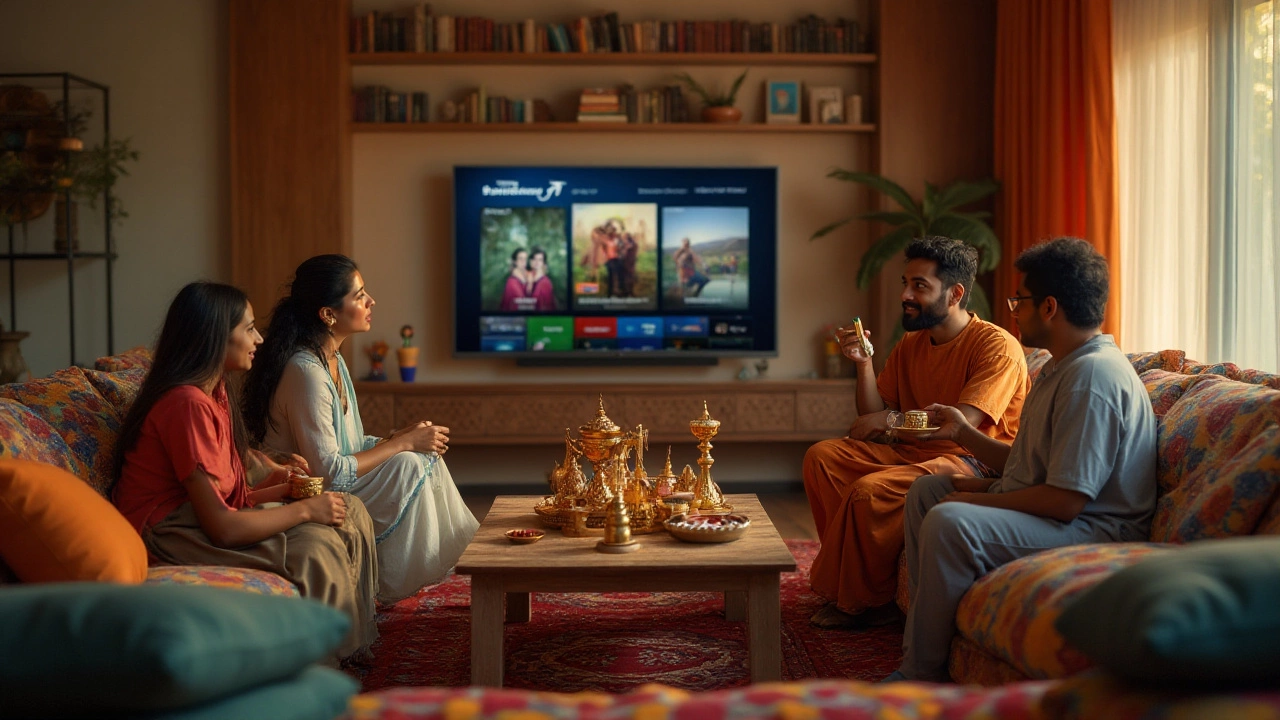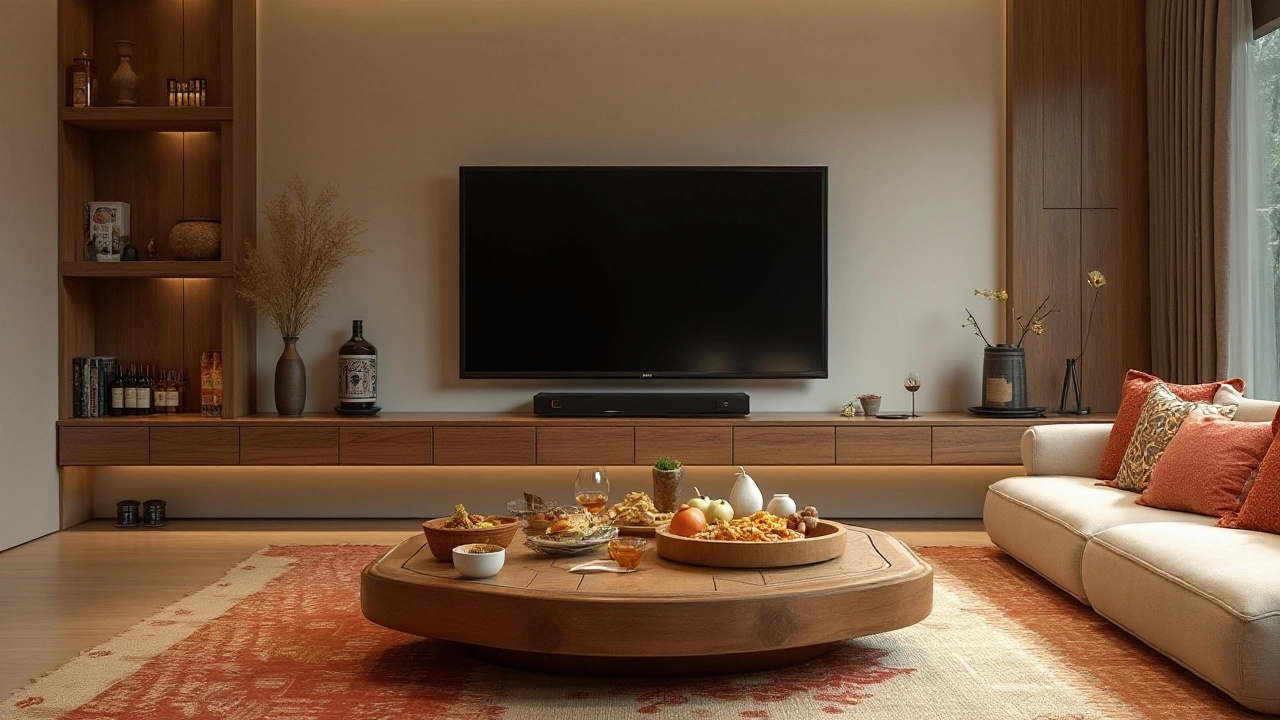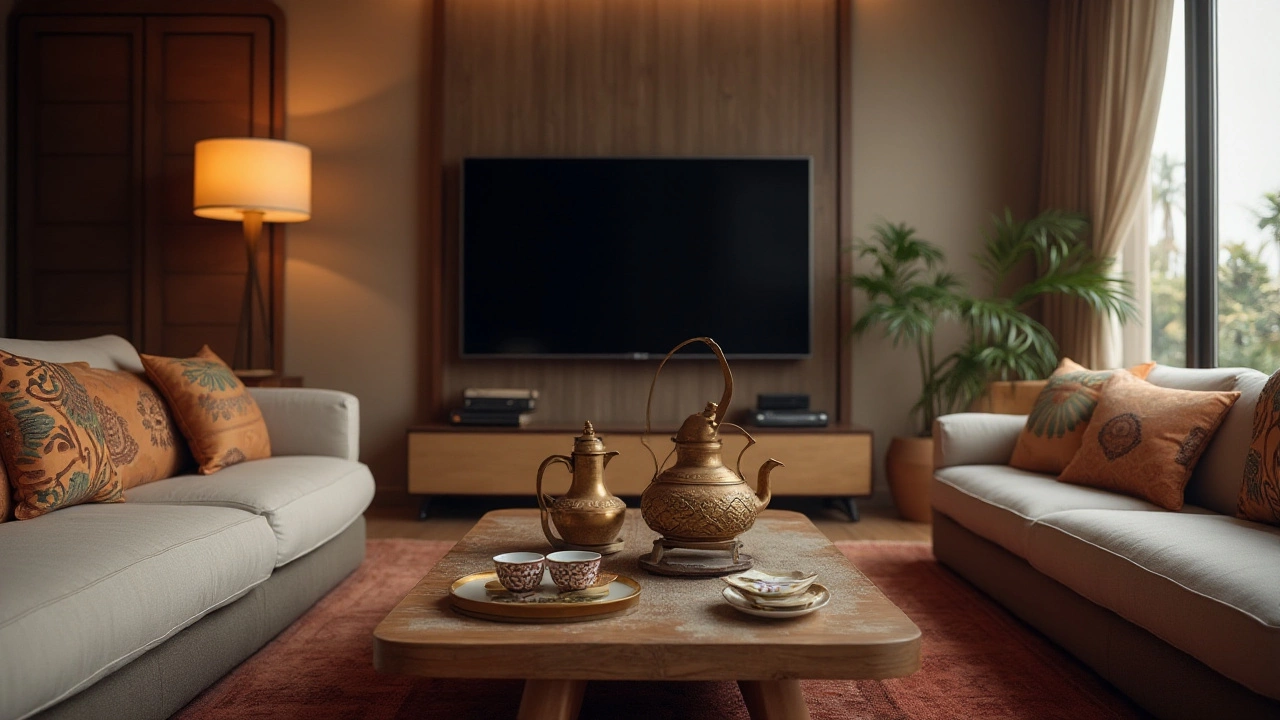The modern living room often revolves around the television, that sleek, bright rectangle of entertainment and information. With a 55-inch TV, achieving the perfect balance between comfort and style is key—particularly when it comes to deciding just how far away to sit. It's not just about personal preference; there are practical reasons and guidelines that can help optimize your viewing experience.
In this article, we'll unravel the factors influencing the ideal viewing distance for a 55-inch television, from screen resolutions to room dimensions, and how thoughtful furniture arrangements, especially coffee tables, can enhance your space. Prepare to discover tips that go beyond simple measurements, offering insights that marry interior design with optimal viewing comfort.
- Understanding TV Size and Viewing Angle
- Calculating the Ideal Distance
- Balancing Style with Functionality
- The Role of Coffee Tables in Layout
- Tips for a Comfortable Viewing Experience
Understanding TV Size and Viewing Angle
The size of your TV doesn't just define its presence in your living room; it also determines how you interact with it. A 55-inch TV strikes a balance between not too overwhelming and adequately immersive for many viewers. But what does this mean for how you should sit? The human eye captures a limited field of view comfortably, which translates into specific angles and distances when it comes to enjoying your television. Engineers and industry experts often recommend a viewing angle of about 30 to 40 degrees to capture the entire screen comfortably without having to reduce clarity, enabling you to enjoy the intricate details offered by modern high-definition TVs. To truly optimize your TV viewing distance, it’s crucial to understand these angles as they correlate directly with the screen size.
Now, let's bring numbers into the picture. With your 55-inch TV, the diagonal size naturally influences how you compute the sitting arrangement. By applying some simple math, you can translate screen inches to ideal sitting distances in feet. For instance, a common rule is sitting at a distance of 1.5 to 2.5 times the diagonal screen size. This means for a 55-inch TV, you should be sitting around 6.9 to 11.5 feet away. This distance ensures your entire field of view is filled with the screen, providing an immersive experience without losing picture quality. To achieve this, many recommend the 4K TV standard where pixel density allows for closer proximity viewing without visible distortion.
A significant point to consider when discussing angles is the resolution of your TV. A higher resolution, like 4K Ultra HD, allows closer viewing distances as the images remain crisp even up close. With a 4K TV, getting as close as 4.5 feet for your 55-inch TV isn’t outlandish, letting you experience stunning clarity and detail. This is unlike older HD TVs, where pixels become discernible at closer ranges, detracting from the viewing experience. An intriguing aspect highlighted by the Society of Motion Picture and Television Engineers specifies that your primary seat should cover a 30-degree angle for movies to recreate a theater-like experience. It's a fascinating intersection of science and art that makes TV viewing such a personal yet universally engaging activity.
"The optimal viewing experience for television is both a science and an art, blending aesthetics with function for the best results," says a senior researcher at the Consumer Electronics Association.
Beyond measured calculations, real-life integration is essential. Your seating setup plays a huge role in how comfortably you view your screen. The combination of seating height relative to the TV screen can influence the vertical viewing angle, which should ideally be within 15 degrees of eye level. Achieving the right blend doesn’t only mean considering technology but also factoring in room aesthetics, such as furniture placements including your coffee table. While the TV's size and your room separation should guide setup, personal comfort shouldn’t be neglected. You should feel relaxed and naturally how you'd congregate for viewing, be it a solo binge session or with family and friends.
The Influence of Room Layout
Your living room's space and shape invariably impact how you incorporate your 55-inch TV. Rooms with elongated lengths versus cozy square rooms require different approaches to TV placement. In wide rooms, positioning the TV centrally might require alternate seating arrangements, while longer rooms can exploit the advantage of pulling couches and chairs back so as not to mess with the suggested angle. Of course, a pivotal element in all this is the presence of a coffee table, which doesn’t just stand as a functional piece, but one that adds aesthetic value and guides traffic flow.
| Screen Size | Viewing Distance (Min) | Viewing Distance (Max) |
|---|---|---|
| 55-inch | 4.5 feet (4K Resolution) | 11.5 feet (HD Resolution) |
Calculating the Ideal Distance
Determining the optimal viewing distance for your 55-inch TV involves a blend of science, comfort, and a little bit of art. This balance ensures that you enjoy a sharp, compelling picture without feeling overwhelmed or straining your eyes. The ideal distance is not a one-size-fits-all measurement but rather a guideline that you can adjust based on your unique space and preferences. Most experts suggest that the distance between your eyes and the TV screen should be about 1.5 to 2.5 times the diagonal size of the television. For a TV with a diagonal measurement of 55 inches, this results in a viewing distance ranging from approximately 6.9 feet (or 2.1 meters) to 11.4 feet (or 3.5 meters). But why stop there? Personal comfort plays a starring role, too, and it might mean sitting a little closer to appreciate the fine details of your 4K or 8K screen, or a bit further back if you're watching sports or engaging in a casual movie night. The key is to find that sweet spot where your immersion in content feels just right with your living environment.
Several factors come into play when you decide on the ideal placement. Room size is naturally a significant consideration; however, don't overlook seating arrangement dynamics or the coffee table placement as part of the overall room design. If you have high seating that puts your eyes well above the TV centerline, you might want to adjust accordingly, so you're not always looking down or up, potentially causing discomfort over time. With bigger rooms, longer distances might be tempting but remember that prolonged distances can limit the visual resolution benefits of a 4K display, prompting you to miss out on the crisp picture quality. In a smaller room, where seating distances are tighter, make sure there's enough space to allow for unobstructed views and movement—but not so much that you're crowded by tables and chairs. To visualize your optimum spot, try sitting in different places until you strike the right balance between clarity and distinction at various content scales.
In 2016, a leading study by the Society for Motion Picture and Television Engineers suggested that for proper high-definition viewing, ideally, a screen should fill at least 30 degrees of your field of view. Translating that into practical terms can help specify where to park your couch or arrange your beanbags for the perfect experience. This can feel a bit technical, but once you apply some practical tests, it becomes intuitive. For big events like movies or sports games, consider pushing your seating towards the lower end of the recommended distance range to pack the action into your field of view. If it’s about cozying up with family or friends for some casual TV watching or gaming, you might find the upper range more fitting.
"Sitting at the right distance is like savoring a finely brewed cup of coffee," notes Julia Segal, a noted interior designer. "Too far and you miss the aroma; too close and it burns. It’s about finding the balance that’s just perfect for your taste."
Taking these thoughts into your ongoing room planning can make all the difference between passively watching the television, filling up idle hours, and actively being sported away by the endless realism and thrill of your favorite shows and games. Seamlessly blend technicality with your gut feeling for design and spatial awareness, and therein lies your answer to positioning, elegance, and efficient use of space. A well-planned viewing distance complements the living room’s mood, energizes relaxation, and makes entertainment more satisfying.

Balancing Style with Functionality
Designing a living room around a 55-inch TV demands a delicate dance between aesthetics and practicality. It's not just about planting your TV at the recommended distance from your couch; it's about ensuring that the space feels cohesive and inviting. The TV could be the centerpiece, but it shouldn't overwhelm the room. Consider the visual flow of your room. How do the furniture pieces interact with one another? The TV, while essential, is a part of a larger ensemble that includes the couch, coffee table, and any other furniture.
First, take stock of your room's layout. Is your TV wall-mounted or sitting on a stand? Both have implications for how space functions. Wall mounting might offer more floor space flexibility, allowing for more creative coffee table placements, while a stand could have storage that helps keep living room clutter at bay. In smaller spaces, every inch of floor space is precious. Ensuring your TV isn't encroaching on your navigation areas is a way of achieving harmony between style and function.
A stylish setup is about subtlety. Overstate your arrangement and you risk detracting from both comfort and visual appeal. Think about the height of your TV relative to seating. To minimize neck strain, the center of your TV should be at eye level when sitting down. This alignment supports both function and style, keeping aesthetics sharp without sacrificing comfort.
Coffee tables, often considered the anchor of a living room, are pivotal in both style and functional strategies. Select a design that echoes the room's style, whether that's sleek modern minimalism or cozy rustic charm. A well-chosen coffee table complements the TV and seating, aiding in the room's storytelling. Consider tables with adjustable heights, which can serve multiple functions from dining to working, mitigating the space occupied by extra furniture.
"Design is not just what it looks like and feels like. Design is how it works." — Steve Jobs
Also, the placement is crucial. Ensure it doesn’t obstruct pathways or screen views. As a rule of thumb, aim for about 18 inches of space between the coffee table and seating, offering enough legroom while bringing drinks, snacks, or remotes within arm’s reach. To enhance functionality without compromising sightlines, opt for low-profile tables that let the TV viewing distance remain unobstructed.
Additionally, pay attention to materials and finishes. Wooden tables with natural grains can add warmth, while glass or acrylic ones may lend a room modern airiness. Decorate it sparingly, incorporating items of varying heights for visual interest while avoiding clutter. Stacking a few books, adding a small tray for remotes, or setting a plant could bring life and personality, crafting a living room that's as stylish as it is functional.
The Role of Coffee Tables in Layout
Coffee tables often serve as the unsung heroes in a living room layout, striking a balance between functionality and aesthetic appeal. When arranging a space with a 55-inch TV, the coffee table does much more than just hold your magazines or the occasional cup of coffee. It plays a crucial role in defining the room's flow and ensuring you have a comfortable viewing distance from your TV. As a rule of thumb, the distance from the sofa to the coffee table should be about 14 to 18 inches for ease of access, which coincidentally complements the viewing distance variable.
In design choices where style meets function, the height of the coffee table is equally significant. Ideally, the table should be about the same height as the cushions on your sofa, which allows for a harmonious visual line and ensures that your field of view remains unobstructed. For those who enjoy modern and minimalistic designs, selecting a clear or glass coffee table can prevent the area from feeling cluttered, which is particularly advantageous in smaller spaces. Such transparency allows the living room to feel more open, counterbalancing the sizeable presence of a 55-inch TV.
Moreover, the coffee table can act as a central piece around which the rest of the room's furniture orbits. This creates a cohesive look whereby the TV is not just a standalone element, but a part of a connected space. As interior designer Nate Berkus once said,
"It's about making sure that every piece speaks to each other... creating unity in your design choices."The coffee table thus bridges the visual gap between the TV and the seating area, making the room feel balanced and inviting.
There's also the aspect of utilizing the coffee table for storage. Many contemporary designs incorporate hidden storage spaces within the table itself. This clever feature can help you maintain a clean and organized living area, hiding away remote controls, throws, or even gaming consoles linked to your TV. In rooms where space is at a premium, this can be a game-changer, allowing you to keep necessary items within arm's reach without compromising on the room's appearance.
Finally, consider the shape and material of your coffee table in relation to the TV. Round tables, for instance, can soften the sharp lines of a rectangular TV screen, adding a touch of elegance and offsetting any harshness in your living room’s visual aesthetic. Wood and metal combinations can offer durability and style, blending traditional and industrial themes that enhance the character of your space. Selecting the right coffee table underlines not only its practical uses but also showcases your personal style, making every movie night or TV marathon a delight in a well-curated environment.

Tips for a Comfortable Viewing Experience
Finding oneself submerged in a captivating movie or an intense gaming session is a pleasure like no other, and a perfectly set viewing area can greatly enhance this experience. The TV viewing distance plays a crucial role, but there's more to it than just measuring the space between your couch and the screen. To start with, the room's lighting should create an atmosphere that doesn't strain your eyes. Balancing artificial light and natural light means being able to adjust shades or switching lamps on and off, aiming for soft, indirect lighting rather than glare reflected off your TV.
Next, consider the placement and height of the television itself. Ideally, the center of the screen should be at eye level when you're seated. This helps in maintaining a natural posture and reduces neck strain. Mounting your 55-inch TV at the appropriate height or adjusting its stand accordingly can ensure hours of viewing without discomfort. Notably, the distortion at the edges of the screen is minimized this way, giving you a better viewing perspective.
"It's incredible how a few simple adjustments can turn an ordinary TV setup into a personal theater," suggests a top interior designer in a recent piece from Living Room Monthly.
A significant component of perfecting your viewing comfort lies in seating ergonomics. Selecting the right sofa or recliner that offers ample support is imperative. Pay close attention to the distance to ensure everyone gets a clear view of the screen, working around the guidance of 1.5 to 2.5 times the diagonal screen size. This means sitting about 6.8 to 11.4 feet away from a 55-inch TV—factors like room size and personal comfort may make closer or more distant seating optimal.
Then, let's not forget about coffee table placement. When too close, it obstructs legroom, and when too far, it becomes inconvenient. The general recommendation is to place it about 18 inches from the seating area. This allows for easy access without encroaching on the all-important TV viewing path. Sometimes adding a textured or patterned design element on the table can draw interest away from tech-heavy setups, bringing a homely touch to your arrangement.
Lastly, let us consider sound quality as part of your viewing comfort. The built-in speakers of a modern TV might suffice in smaller spaces, but coupling your setup with a soundbar or a surround sound system can make a tremendous difference. Position these peripherals correctly to envelop yourself in sound that's perfectly synchronized with the action on screen. Remember to test different volumes and sound modes, especially for late-night viewing, where clarity often needs a different setup.
Your goal is to create a sanctuary of entertainment. With these tips, you can transform mere TV time into an unforgettable cinematic experience. Keep the principle of balance in mind—be it lighting, seating, or sound—and revel in the harmony that follows.

